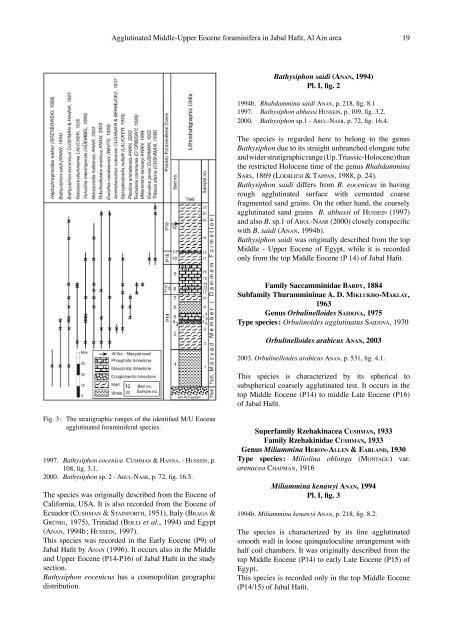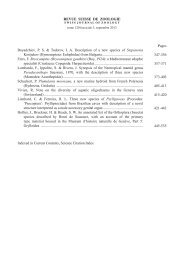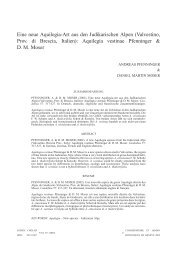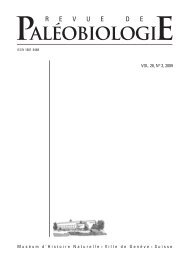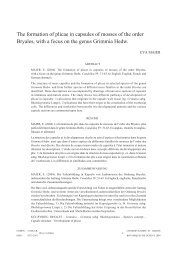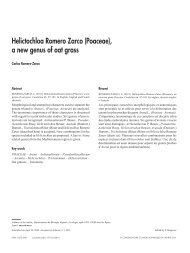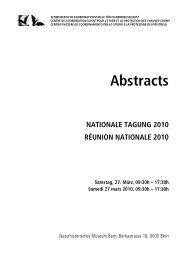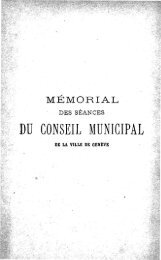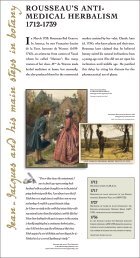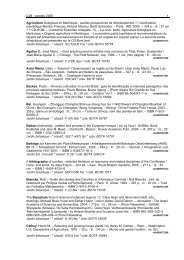Agglutinated Middle-Upper Eocene foraminifera in Jabal Hafit, Al ...
Agglutinated Middle-Upper Eocene foraminifera in Jabal Hafit, Al ...
Agglutinated Middle-Upper Eocene foraminifera in Jabal Hafit, Al ...
Create successful ePaper yourself
Turn your PDF publications into a flip-book with our unique Google optimized e-Paper software.
<strong>Agglut<strong>in</strong>ated</strong> <strong>Middle</strong>-<strong>Upper</strong> <strong>Eocene</strong> <strong>foram<strong>in</strong>ifera</strong> <strong>in</strong> <strong>Jabal</strong> <strong>Hafit</strong>, <strong>Al</strong> A<strong>in</strong> area 19<br />
Fig. 3 : The stratigraphic ranges of the identified M/U <strong>Eocene</strong><br />
agglut<strong>in</strong>ated <strong>foram<strong>in</strong>ifera</strong>l species.<br />
1997. Bathysiphon eocenica CUSHMAN & HANNA. - HUSSEIN, p.<br />
108, fig. 3.1.<br />
2000. Bathysiphon sp. 2 - ABUL-NASR, p. 72, fig. 16.5.<br />
The species was orig<strong>in</strong>ally described from the <strong>Eocene</strong> of<br />
California, USA. It is also recorded from the <strong>Eocene</strong> of<br />
Ecuador (CUSHMAN & STAINFORTH, 1951), Italy (BRAGA &<br />
GRÜNIG, 1975), Tr<strong>in</strong>idad (BOLLI et al., 1994) and Egypt<br />
(ANAN, 1994b ; HUSSEIN, 1997).<br />
This species was recorded <strong>in</strong> the Early <strong>Eocene</strong> (P9) of<br />
<strong>Jabal</strong> <strong>Hafit</strong> by ANAN (1996). It occurs also <strong>in</strong> the <strong>Middle</strong><br />
and <strong>Upper</strong> <strong>Eocene</strong> (P14-P16) of <strong>Jabal</strong> <strong>Hafit</strong> <strong>in</strong> the study<br />
section.<br />
Bathysiphon eocenicus has a cosmopolitan geographic<br />
distribution.<br />
Bathysiphon saidi (ANAN, 1994)<br />
Pl. I, fig. 2<br />
1994b. Rhabdamm<strong>in</strong>a saidi ANAN, p. 218, fig. 8.1<br />
1997. Bathysiphon abbassi HUSSEIN, p. 109, fig. 3.2.<br />
2000. Bathysiphon sp.1 - ABUL-NASR, p. 72, fig. 16.4.<br />
The species is regarded here to belong to the genus<br />
Bathysiphon due to its straight unbranched elongate tube<br />
and wider stratigraphic range (Up. Triassic-Holocene) than<br />
the restricted Holocene time of the genus Rhabdamm<strong>in</strong>a<br />
SARS, 1869 (LOEBLICH & TAPPAN, 1988, p. 24).<br />
Bathysiphon saidi differs from B. eocenicus <strong>in</strong> hav<strong>in</strong>g<br />
rough agglut<strong>in</strong>ated surface with cemented coarse<br />
fragmented sand gra<strong>in</strong>s. On the other hand, the coarsely<br />
agglut<strong>in</strong>ated sand gra<strong>in</strong>s B. abbassi of HUSSEIN (1997)<br />
and also B. sp.1 of ABUL-NASR (2000) closely conspecific<br />
with B. saidi (ANAN, 1994b).<br />
Bathysiphon saidi was orig<strong>in</strong>ally described from the top<br />
<strong>Middle</strong> - <strong>Upper</strong> <strong>Eocene</strong> of Egypt, while it is recorded<br />
only from the top <strong>Middle</strong> <strong>Eocene</strong> (P 14) of <strong>Jabal</strong> <strong>Hafit</strong>.<br />
Family Saccamm<strong>in</strong>idae BARDY, 1884<br />
Subfamily Thuramm<strong>in</strong><strong>in</strong>ae A. D. MIKLUKHO-MAKLAY,<br />
1963<br />
Genus Orbul<strong>in</strong>elloides SAIDOVA, 1975<br />
Type species : Orbul<strong>in</strong>oides agglut<strong>in</strong>atus SAIDOVA, 1970<br />
Orbul<strong>in</strong>elloides arabicus ANAN, 2003<br />
2003. Orbul<strong>in</strong>elloides arabicus ANAN, p. 531, fig. 4.1.<br />
This species is characterized by its spherical to<br />
subspherical coarsely agglut<strong>in</strong>ated test. It occurs <strong>in</strong> the<br />
top <strong>Middle</strong> <strong>Eocene</strong> (P14) to middle Late <strong>Eocene</strong> (P16)<br />
of <strong>Jabal</strong> <strong>Hafit</strong>.<br />
Superfamily Rzehak<strong>in</strong>acea CUSHMAN, 1933<br />
Family Rzehak<strong>in</strong>idae CUSHMAN, 1933<br />
Genus Miliamm<strong>in</strong>a HERON-ALLEN & EARLAND, 1930<br />
Type species : Miliol<strong>in</strong>a oblonga (MONTAGU) var.<br />
arenacea CHAPMAN, 1916<br />
Miliamm<strong>in</strong>a kenawyi ANAN, 1994<br />
Pl. I, fig. 3<br />
1994b. Miliamm<strong>in</strong>a kenawyi ANAN, p. 218, fig. 8.2.<br />
The species is characterized by its f<strong>in</strong>e agglut<strong>in</strong>ated<br />
smooth wall <strong>in</strong> loose qu<strong>in</strong>quelocul<strong>in</strong>e arrangement with<br />
half coil chambers. It was orig<strong>in</strong>ally described from the<br />
top <strong>Middle</strong> <strong>Eocene</strong> (P14) to early Late <strong>Eocene</strong> (P15) of<br />
Egypt.<br />
This species is recorded only <strong>in</strong> the top <strong>Middle</strong> <strong>Eocene</strong><br />
(P14/15) of <strong>Jabal</strong> <strong>Hafit</strong>.


